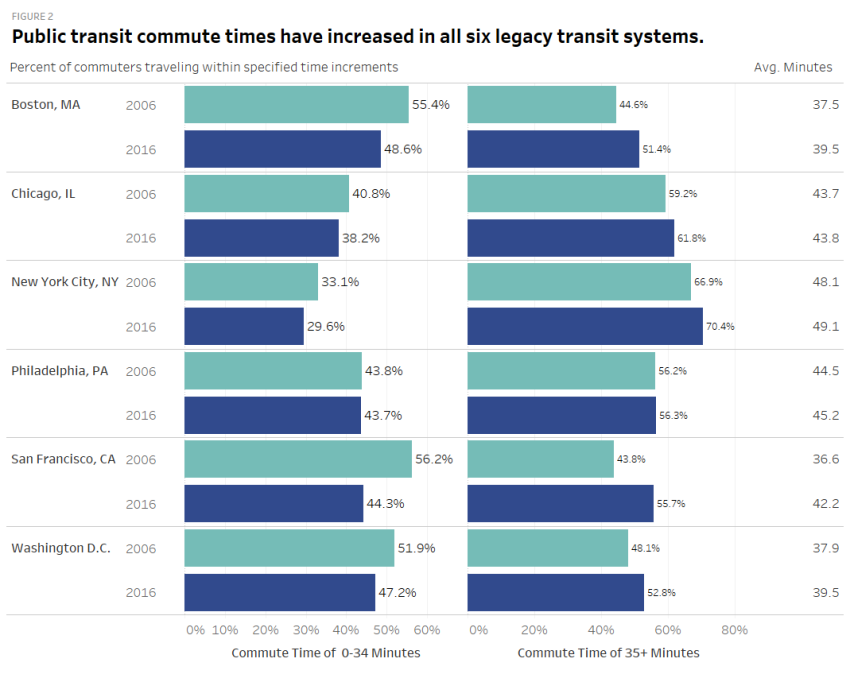The MBTA vs. Other Legacy Transit Systems: How Do We Compare?
By Peter Ciurczak
February 28, 2018
This is an online version of our Boston Research Snapshot email newsletter from February, 2018. Sign up to get the newsletter in your inbox every month.
Earlier this month, the Boston Foundation, the Barr Foundation and A Better City released The Transportation Dividend: Transit Investments and the Massachusetts Economy, which quantifies the economic value generated by our region’s longstanding public transit system. The report lays out a proposal for long overdue transit investments in 20 “inner core” communities and it places this work in the context of similar challenges faced by five other legacy transit cities: San Francisco, Chicago, Philadelphia, Washington D.C., and New York City. These six cities are ‘densely populated, older metropolitan areas,’ and feature some of the highest shares of public transit commuters in the United States. They also have aging infrastructure that has been poorly maintained in recent years. Through the following four graphs we compare and contrast the experience of public transit in Boston to these five other legacy systems.
Nearly half of Bostonians use alternative, non-car means to get to work, placing us in the middle of the pack when compared to the other systems. In all six systems, more than a third take alternative transit modes. At 14 percent, Boston and D.C. have the highest shares of commuters who walk to work.
One legacy system that been in the news recently for its decreasing reliability is New York City’s MTA. Even though it’s a very dense city, New York has the highest share of transit commutes taking 35 minutes or more. This recent New York Times video details MTA disinvestment in recent years, a story that sounds very similar to dynamics at play here, where aging MBTA infrastructure is a key cause of longer commute times.
Old equipment and years of deferred maintenance have led to an increase in the MBTA’s backlog of ‘state of good repair’ projects. At the MBTA, older buses, subways and other aging equipment can rack up maintenance or replacement costs in the billions. The system’s buses exemplify this problem. They are the oldest buses among all the legacy transit systems, at an average of 11.7 years. Built for a working lifespan of 12 years, most of the system’s buses will need to be replaced within the next six years. Boston’s subway system is also quite old. The MBTA’s trains range in age from roughly 10 years on the Blue line, to the almost 50 years on the Red line.
Newer trains are capable of starting and stopping much more rapidly, and the MBTA’s recent purchase of Orange Line trains (2018 delivery) should help reduce headways to four or five minutes once the trains are finally put into service. New Red Line trains (2019 delivery) will also help reduce headway on that line to three minutes.
That said, headway is only one way of measuring service quality. To better gauge this, the MBTA recently started measuring what percentage of users waited for less time than the scheduled headway before getting on a train. MassPIRG’s How Reliable is the T suggests that this may not be a full picture of reliability. To better understand subway user experience, MassPIRG recommends the MBTA measure not only how many passengers wait half the scheduled headway, but also how long they spend on the train in excess of their scheduled trip.
Robust, legacy transit systems are a tremendously valuable public asset. Recent MassINC polling shows that Bay Staters recognize the importance of a transit system in powering a strong economy. But transit systems, especially older legacy systems, require ongoing attention and investment in order to maintain them over the long haul. It’s not too late to invest in the MBTA for the reliable use of current and future generations, but it will likely take a comprehensive public plan in order to make up for the neglect it has faced over recent years.

